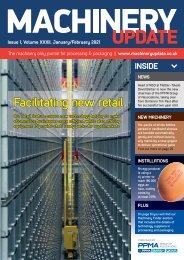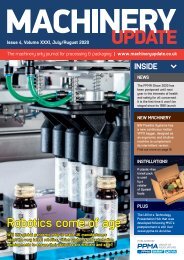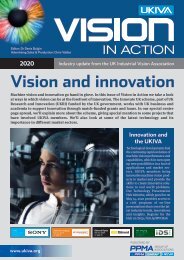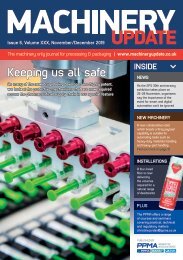Vision in Action Autumn 2019
You also want an ePaper? Increase the reach of your titles
YUMPU automatically turns print PDFs into web optimized ePapers that Google loves.
16<br />
LIGHTING THE WAY TO 3D<br />
The four ma<strong>in</strong> 3D imag<strong>in</strong>g techniques, stereo vision,<br />
laser l<strong>in</strong>e triangulation, structured light and Time of<br />
Flight (ToF) use light <strong>in</strong> very different ways.<br />
Stereo vision<br />
Stereo vision replicates human vision by view<strong>in</strong>g a scene from two<br />
different positions us<strong>in</strong>g two cameras. Special match<strong>in</strong>g algorithms<br />
compare the two images, search for correspond<strong>in</strong>g po<strong>in</strong>ts and visualise<br />
all po<strong>in</strong>t displacements <strong>in</strong> a Disparity Map. S<strong>in</strong>ce the view<strong>in</strong>g angles and<br />
separation of the cameras is known, triangulation can be used to<br />
calculate the co-ord<strong>in</strong>ates of each pixel <strong>in</strong> the image to create a 3D po<strong>in</strong>t<br />
cloud. In passive stereo applications, the images are acquired us<strong>in</strong>g<br />
ambient light, but the quality of the resultant po<strong>in</strong>t cloud depends<br />
directly on both the light and object<br />
surface textures. Some applications<br />
therefore require active stereo vision,<br />
where a random light pattern of dots<br />
is projected onto the object surfaces<br />
to give a high-contrast texture and<br />
much better quality results.<br />
Laser l<strong>in</strong>e triangulation<br />
Here, a laser l<strong>in</strong>e is projected onto the<br />
surface of the object which moves<br />
beneath it. The l<strong>in</strong>e profile is distorted<br />
by the object and this is imaged by<br />
one or more cameras located at fixed<br />
distances and angles to the light<br />
surface. As the object moves under<br />
the l<strong>in</strong>e, the system builds up a series<br />
of profiles which represent the<br />
topology of the object. Aga<strong>in</strong> us<strong>in</strong>g<br />
triangulation methods, these profiles<br />
can be used to calculate the 3D po<strong>in</strong>t<br />
cloud.<br />
3D DATA PROCESSING<br />
Process<strong>in</strong>g 3D data and creat<strong>in</strong>g 3D images is<br />
computationally <strong>in</strong>tensive, and the evolution of high<br />
performance PCs was one of the key driv<strong>in</strong>g forces <strong>in</strong><br />
mak<strong>in</strong>g 3D imag<strong>in</strong>g an affordable ma<strong>in</strong>stream mach<strong>in</strong>e<br />
vision technique. Initially camera data was transferred to a<br />
PC, where the 3D po<strong>in</strong>t clouds were calculated and the<br />
various 3D measurements made. However the application<br />
of 3D imag<strong>in</strong>g to measure f<strong>in</strong>er details on faster <strong>in</strong>dustrial<br />
processes has required the use of higher resolution<br />
cameras at higher frame rates which generates larger data<br />
volumes that must be transmitted to the PC. The network<br />
bandwidth for data transmission to the PC must be<br />
optimised to avoid time delays or data loss. The process<strong>in</strong>g<br />
power of the PC hardware must also keep pace with the<br />
<strong>in</strong>creased process<strong>in</strong>g needs <strong>in</strong> order not to restrict the<br />
overall system.<br />
Mov<strong>in</strong>g data process<strong>in</strong>g<br />
The key to overcom<strong>in</strong>g these issues is to move the 3D data process<strong>in</strong>g<br />
away from the PC CPU. Today’s FPGA and multicore embedded<br />
processor architectures make it possible to do these calculations at<br />
much faster speeds. However, there may still be concerns about data<br />
transfer speeds to the PC, so there is an <strong>in</strong>creas<strong>in</strong>g move from camera<br />
Structured light<br />
Structured light, normally <strong>in</strong> the form<br />
of parallel l<strong>in</strong>es is projected onto the<br />
object. The distortion <strong>in</strong> the l<strong>in</strong>es<br />
caused by the shape of the object is<br />
captured by the camera and is used<br />
to calculate depth, structure and<br />
detail, by know<strong>in</strong>g the distance and<br />
angle between the projected light and<br />
the camera. This technique may be<br />
used with two cameras or a s<strong>in</strong>gle<br />
camera and is <strong>in</strong>dependent of the<br />
object’s texture.<br />
Time of flight<br />
In ToF systems the time taken for<br />
light emitted from the system to<br />
return to the sensor after reflection<br />
from each po<strong>in</strong>t of the object is<br />
measured. The direct ToF method<br />
(also known as pulse modulation)<br />
measures the return time of short<br />
pulses – this is longer the further<br />
away the imag<strong>in</strong>g po<strong>in</strong>t is from the<br />
sensor. The cont<strong>in</strong>uous wave<br />
modulation method uses a<br />
cont<strong>in</strong>uous signal and calculates the<br />
phase shift between the emitted and<br />
return<strong>in</strong>g light waves which is<br />
proportional to the distance to the<br />
object.<br />
www.ukiva.org<br />
3D Techniques<br />
(courtesy ClearView Imag<strong>in</strong>g)<br />
Mov<strong>in</strong>g process<strong>in</strong>g from PC to camera<br />
(Courtesy IDS Imag<strong>in</strong>g Development Systems)<br />
manufacturers to provide fast, direct memory access between image<br />
acquisition and process<strong>in</strong>g on a dedicated FPGA processor mounted<br />
either <strong>in</strong> the camera itself or <strong>in</strong> a separate module l<strong>in</strong>ked to the cameras,<br />
before transfer to a PC for further process<strong>in</strong>g. The transfer of 3D result<br />
data <strong>in</strong>stead of high-resolution 2D raw data significantly reduces the<br />
network load.<br />
Gett<strong>in</strong>g results<br />
For PC process<strong>in</strong>g, the major mach<strong>in</strong>e vision software packages offer an<br />
extensive range of 3D tools, beg<strong>in</strong>n<strong>in</strong>g with the construction of 3D depth<br />
maps or po<strong>in</strong>t clouds from any of the 3D imag<strong>in</strong>g techniques and system<br />
calibration. Other functionality typically <strong>in</strong>cludes 3D registration, 3D<br />
object process<strong>in</strong>g, surface-based 3D match<strong>in</strong>g and 3D Surface<br />
Inspection. These packages can handle multi-camera applications and<br />
smart cameras can also be l<strong>in</strong>ked for extended imag<strong>in</strong>g. Smart 3D<br />
cameras comb<strong>in</strong>e on-board process<strong>in</strong>g with a comprehensive range of<br />
measurement tools or application-specific packages, which means that<br />
they are completely self-conta<strong>in</strong>ed and do not need any ancillary PC<br />
process<strong>in</strong>g.

















